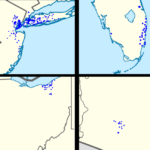New research challenges the idea that black holes formed after the first stars and galaxies
- Supermassive black holes may have been present during the first 50 million years of the universe
- Black holes could have influenced the evolution of galaxies and accelerated star formation
- Data from the James Webb Space Telescope suggests early galaxies were brighter than expected
- Black holes act as cosmic particle accelerators, crushing gas clouds and turning them into stars
- The early universe had two distinct phases: high-speed outflows from black holes and intense star formation
- Future data from the JWST could confirm the new theory and provide answers to fundamental questions
Scientists have long believed that supermassive black holes shaped the galaxies around them, but new research suggests that these black holes could have been present during the first 50 million years of the universe. The James Webb Space Telescope has provided data indicating that early galaxies were brighter than expected, indicating a high number of stars and supermassive black holes. This challenges current theories of cosmic evolution and suggests that black holes and galaxies coexisted and influenced each other in the ancient universe. Black holes act as cosmic particle accelerators, crushing gas clouds and turning them into stars, which explains the brightness of early galaxies. The early universe had two distinct phases: high-speed outflows from black holes and intense star formation. Future data from the JWST could confirm this new theory and provide answers to fundamental questions about the origins of the universe.
Public Companies:
Private Companies:
Key People: Joseph Silk (team leader and professor at Johns Hopkins University)
Factuality Level: 7
Justification: The article presents new research findings about the presence of supermassive black holes in the early universe and their influence on galaxy formation. The information is based on a reanalysis of data from the James Webb Space Telescope. The article provides quotes from the team leader and a professor at Johns Hopkins University, Joseph Silk, who explains the implications of the findings. The article also discusses the current theories of cosmic evolution and how the new research challenges them. Overall, the article presents the research findings and their potential impact on our understanding of galaxy formation, but it does not provide extensive details or scientific evidence to support the claims.
Noise Level: 7
Justification: The article provides a detailed analysis of new research on the presence of supermassive black holes in the early universe and their impact on galaxy formation. It includes quotes from scientists and explains the implications of the findings. The article stays on topic and supports its claims with evidence from the reanalysis of data from the James Webb Space Telescope. However, it does not provide actionable insights or solutions.
Financial Relevance: No
Financial Markets Impacted: No
Presence of Extreme Event: No
Nature of Extreme Event: No
Impact Rating of the Extreme Event: No
Justification: The article does not pertain to financial topics and does not describe any extreme events.
 www.space.com
www.space.com 





